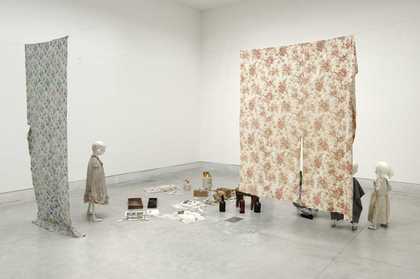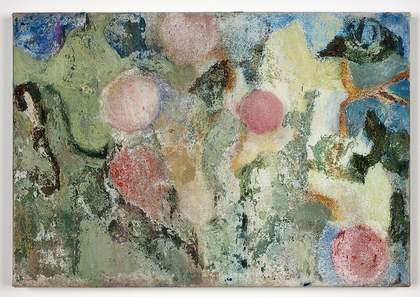
Detail from Cathy Wilkes's Untitled 2014 installation at Tramway, Glasgow
© Cathy Wilkes, Rennie Collection, Vancouver, courtesy the artist and The Modern Institute/Toby Webster Ltd, Glasgow
‘Richly suggestive, elliptical and movingly understated, Wilkes’s work makes you feel time, see mood, touch spaces.’ And ‘Nothing can quite prepare you for the exhilarating ordinariness of the art of Cathy Wilkes.’ These are two quotes from recent reviews about how the artist’s enigmatic yet alluring installations and assemblages can delight and baffle viewers in equal measure.
Part of this may be due to her choice of materials, which can include such diverse objects as old sinks, toys, food packets, cups and bottles, phones, strangely dressed shop mannequins and bits of patterned cloth. Many have been used previously or distressed. More recently she has replaced mannequins with handmade papier mâché figures.
Wilkes’s installations have a strange theatricality to them, which is down to the process of their creation, starting with the collection and selection of materials that are then carefully arranged and rearranged until their final configuration. (She has called her practice ‘a process of open concentration and waiting’.) Her personal experience and biography can shape the nature of many of the works, even if this is not made explicit in what we see. For her exhibition at Tate Liverpool (which includes some of her paintings), she will re-stage several of her previous installations into what will become, essentially, one very large piece.

Cathy Wilkes Untitled 2013 Installation view ‘The Encyclopedic Palace’, Venice Biennale, Venice, 2013
Courtesy of The Artist and The Modern Institute/Toby Webster Ltd, Glasgow Photo: Cristiano Corte

Cathy Wilkes
Untitled 2012
Oil on canvas, 260 x 360mm
© Cathy Wilkes, courtesy the artist and The Modern Institute/Toby Webster Ltd, Glasgow
One recurrent element is the depiction or semblance of the human figure, first in the shape of mannequins and in the past few years with the papier mâché figures. Despite the difference in material and the fact that Wilkes has crafted these objects herself, you could say there is a similar underlying sentiment at work as to what these figures represent. And what is that? Previously, she has written about the mannequins, for example:
I have used shop mannequins (and also the motif of the nurse) to try to feel what someone else feels in art – looking for yourself in a piece of art, trying to see what someone else saw. It’s to do with the separation that there is between people, and the impossibility of completely feeling what someone else feels. I think this is most extreme, human and painful when someone is caring for someone else – or is nursing someone and trying to feel what they feel and be a companion to them. It might just be in friendship, or it might be in actual nursing, or in a relationship, but to try to feel what someone else feels and to accompany them in their experience of life and in their suffering, to me is related to what I am looking for in language as I apprehend it coming from somewhere outside, from a work of art, or a person, and that it acknowledges in itself the unbridgeable distance between human beings and the vastness of their inner world.
